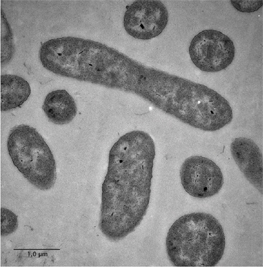The Shewanellaceae are in general considered as of great value for bioremediation for sites contaminated with heavy metals or radioactive waste due to their ability to reduce the respective metal compounds. OS195 is a highly versatile Shewanella baltica strain with respect to usage of electron acceptors and electron donors (Ziemke et al. 1998, Höfle et al. 2000). It is fast growing and easy to be cultivated and shows a fast onset of growth even after prolonged periods of starvation. It also shows good growth at low organic carbon concentration (Brettar et al. unpublished data). OS195 is a potential candidate to be used for bioremediation of sites contaminated with organic pollutants, heavy metals and for energy production in fuel cells. OS195 was isolated in August 1986 from deep water of the Gotland Deep, a 240m deep anoxic basin in the Baltic Sea. OS195 forms part of a large scale collection and study on Shewanella -isolates from the water column of the central Baltic Sea. In this study it was shown that Shewanella baltica had an increased abundance in the low oxic water and at the oxic-anoxic interface (Brettar & Höfle 1993, Brettar et al. 2001). According to clonal analysis of the population structure of Shewanella baltica by RAPD, OS195 formed part of the largest clone (clone "A") that was present in the Baltic Sea in two subsequent years (only 6 out of 13 clones were present over two years) (Ziemke et al. 1997). Clone A is a versatile clone with respect to the use of electron acceptors and electron donors. The genome-sequenced S. baltica strains form part of different clones according to RAPD analysis that fits well with the physiological features, a coincidence that was interpreted as different niches occupied by the different clones (Höfle et al. 2000), Besides their potential use for biotechnological applications, the comparative genome analysis is targeted at a better understanding of the biogeochemical potential and the specific ecological niches of the different S. baltica - clones in the low oxic/anoxic water of the central Baltic Sea. Recent studies in the central Baltic Sea showed that addition of complex organic matter can promote the rapid appearance of "blooms" of Shewanella baltica in the low oxic water of the Baltic Sea (Brettar et al., unpublished data). This potential of S. baltica for rapid growth even after prolonged starvation periods combined with the use of a broad range of different electron acceptors such as oxygen, nitrate, iron, sulfite, or thiosulfate can be of high relevance for the organic matter turnover in a stratified low oxygen environment like the central Baltic Sea. References I. Brettar, M.G. Höfle (1993), Nitrous oxide producing heterotrophic bacteria in the water column of the Baltic sea: abundance and molecular identification. Mar. Ecol. Prog. Ser. 94: 253-265. F. Ziemke, I. Brettar, M.G. Höfle (1997), Stability and diversity of the genetic structure of a Shewanella putrefaciens population in the water column of the central Baltic. Aquat. Microb. Ecol. 13: 63-74. F. Ziemke, Höfle M., Lalucat J., Rossello-Mora R. (1998). Reclassification of Shewanella putrefaciens Owen's genomic group II as Shewanella baltica sp. nov. Int. J. Syst. Bacteriol. 48:179-86. Höfle, M. G., Ziemke, F., I. Brettar (2000), Niche differentiation of Shewanella putrefaciens populations from the Baltic as revealed by molecular and metabolic fingerprinting. In: Bell, C.R. Brylinsky M., and P. Johnson-Green (eds), Microbial Biosystems: New Frontiers, Proceedings of ISME8, Halifax, Canada, p. 135-143. I. Brettar, E.R.B. Moore, M.G. Höfle (2001), dance of novel denitrifying bacteria isolated from the water column of the central Baltic sea. Microb. Ecol. 42: 295-305. **Image Procedure: Cells were fixed with 2.0 % glutardialdehyde (20 mM Hepes, pH 7.0), immobilized in 1% agar, and embedded in epoxy resin. The ultra-thin cuts were post-stained with uranyl-acetate and lead citrate and analyzed by energy-filtered transmission electron microscopy. |
||
|
||
Shewanella baltica OS195

